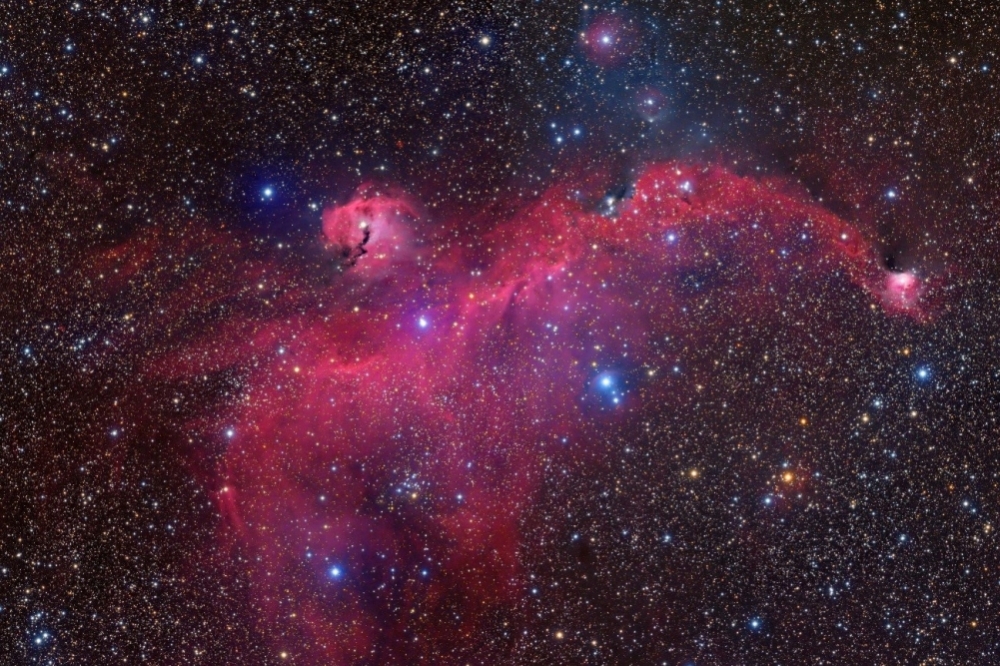

A collaboration involving researchers in Brazil and France studied the origins of the unique shape of this cluster of stars, gas and dust. Their findings showed that the nebula is part of a shell structure produced by three supernova explosions (photo: Bob Franke)
A collaboration involving researchers in Brazil and France studied the origins of the unique shape of this cluster of stars, gas and dust. Their findings showed that the nebula is part of a shell structure produced by three supernova explosions.
A collaboration involving researchers in Brazil and France studied the origins of the unique shape of this cluster of stars, gas and dust. Their findings showed that the nebula is part of a shell structure produced by three supernova explosions.

A collaboration involving researchers in Brazil and France studied the origins of the unique shape of this cluster of stars, gas and dust. Their findings showed that the nebula is part of a shell structure produced by three supernova explosions (photo: Bob Franke)
By José Tadeu Arantes | Agência FAPESP – A study published in the journal Astronomy & Astrophysics explains the origin of the unique shape of the Seagull nebula, officially named Sh 2-296. The study was conducted with the support of FAPESP by researchers affiliated with the University of São Paulo’s Institute of Astronomy, Geophysics and Atmospheric Sciences (IAG-USP) in Brazil and the Paris Institute of Astrophysics (IAP) in France.
According to the article, the nebula is part of a large shell-like structure, which the authors designate the “CMa shell”, enclosing a bubble created by successive supernova explosions. The study identified three “runaway” stars and investigated the possibility that the stars originated in the center of the shell. A runaway star is given this name because it moves through space at an abnormally high velocity and in a direction that points away from its parent group.
“When we analyzed images of the region at various different wavelengths, we could clearly see that the Sh 2-296 nebula is in fact part of a larger structure shaped like an elliptical shell and with a diameter of some 60 parsecs [195.7 light-years],” astronomer Beatriz Fernandes, lead author of the article, told Agência FAPESP.
Fernandes holds a PhD from IAG-USP. Her thesis advisor was Jane Gregorio-Hetem. For her postdoctoral research at IAP in France, she was supervised by Thierry Montmerle.
“We concluded that the three runaway stars were probably ejected from a progenitor cluster by three successive supernova explosions that occurred about 6 million, 2 million and 1 million years ago,” she said.
By backtracing the trajectories of the three runaway stars, the researchers were able to locate the center of the shell. The researchers argue that a group of massive stars in this central region exploded in supernovas and produced a large bow shock (analogous to a bow wave, the curved ridge of water in front of a fast-moving boat created by the force of the bow).
“This was already a known fact about the region, which doesn’t have a single-age population of stars but clusters with slightly different ages. They’re all quite young stars, less than 10 million years old, still in their infancy in astronomical terms,” said Gregorio-Hetem, last author of the article.
The success of the study was due in large part to the European Space Agency’s Gaia Archive, which provided very precise information about the trajectories, velocities and other parameters for Milky Way stars. “The Gaia data enabled us to determine where the runaway stars came from and where they’re going,” Gregorio-Hetem said.
The three stars were considered to be runaways because they are traveling from the center of the shell to its outermost boundary. This is probably because the stars were propelled by the bow shock resulting from the supernova explosions.
The presence of a massive star in itself affects the surrounding cloud of gas and dust because of the intense radiation emitted by the star. Its explosion as a supernova amplifies this effect owing to the shock wave and ejection of large amounts of matter. Such explosions enrich the interstellar medium with the heavy chemical elements synthesized in the interior of the massive star, fueling the chemical evolution of the galaxy.
Open wings
The Seagull nebula, Sh 2-296, is located in the region of the Milky Way named CMa OB1 (Canis Major association OB1), over 3,200 light-years from Earth. The distance between the seagull’s wingtips is approximately 140 light-years.
There are several possible explanations for the fact that we can see only part of the shell. “The cloud may have evolved in such a way that part of the gas dispersed over time. Or it may be that the denser half of the sphere is facing us and we can’t see the other side. More data will be needed to answer this question by three-dimensional mapping,” Gregorio-Hetem said.
The Seagull nebula is not in gravitational equilibrium. It is an open cluster, and its material will continue to expand, albeit at a steadily lower velocity, until the nebula breaks up with the passage of time.
The article “Runaways and shells around the CMa OB1 association” can be retrieved from: www.aanda.org/articles/aa/abs/2019/08/aa35484-19/aa35484-19.html. The complete text can also be downloaded free of charge from Arxiv: arxiv.org/pdf/1906.00113.pdf.
Republish
The Agency FAPESP licenses news via Creative Commons (CC-BY-NC-ND) so that they can be republished free of charge and in a simple way by other digital or printed vehicles. Agência FAPESP must be credited as the source of the content being republished and the name of the reporter (if any) must be attributed. Using the HMTL button below allows compliance with these rules, detailed in Digital Republishing Policy FAPESP.





